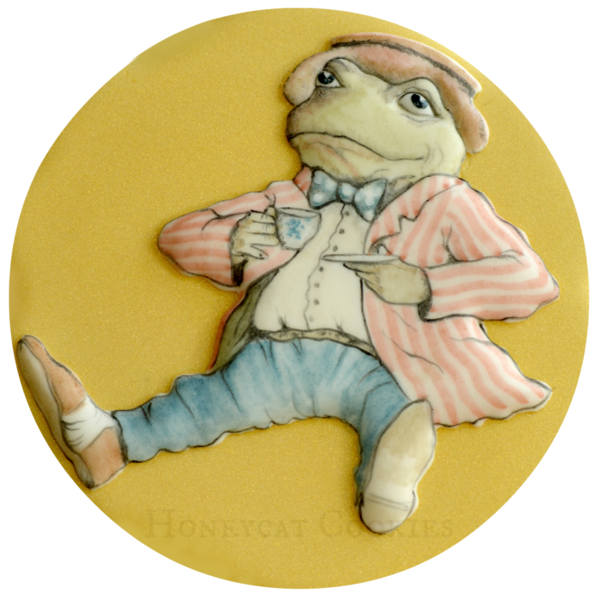
Well, in case you hadn't noticed, it's 2015, and that means I've almost completed a year's worth of these tutorials! So to celebrate, I'm going to do things a little differently today. You might notice there aren't many photos . . . that's because this tutorial is mostly contained in a video! I posted some robin cookies around Christmas, and have had so many questions about the process of handpainting them that I decided it was time I filmed myself doing it so you could all see.
But first a few thoughts about handpainting on cookies: the main thing to remember is that like most of cookie decorating, there is no one correct way to do it! Whatever advice I give you, you'll be able to find a way to paint a cookie doing the opposite! For example, a lot of my efforts in handpainting are about preventing the surface of the icing from breaking down as I paint, but you might actually want to do that deliberately for the effect it creates. You might not want to paint on icing at all, but on the bare cookie. You might want to paint an entire picture from scratch on a blank canvas, or use the painting to embellish a full colour, otherwise complete cookie design.
And much of the time, you're likely to want to do something I've not even thought of, because that's what's so wonderful about the cookie world - all the time cookiers everywhere are experimenting, breaking the "rules", creating new works of art, and hopefully showcasing them right here on Cookie Connection!
I didn't do this robin from my head; the whole time I was painting, I had my computer open to this photograph I found on Pinterest. In fact, I used the photograph as a template to copy the shape of the body onto the flat, white dry royal icing (RI) base. I then piped the eye and beak, let them crust, and piped the body in a thick, white RI flood. I could easily have left out these steps and started painting directly on the base, but I like the added dimension and defined edges that this technique gives. I used it when creating this handpainted copy of Michael Hague's illustration of Toad from The Wind in the Willows. A white base dried in the dehydrator gives a nice, extra smooth surface on which to paint, one that I've found more resistant to breaking down than a richly coloured one.
Equipment and a few extra notes:
Rainbow Dust "Click and Twist" pen, in black. I used this pen to paint the eye first. It's a form of edible black lustre paint I've recently started using that dries hard to the touch, but remains very shiny and deep black, and is perfect for eyes! Once dry though, it remains slightly dissolvable, so you need to be careful when painting around it, or you'll get bleeding. It comes with its own large, coarse brush through which the paint emerges as you twist the base. I never use that brush directly though; as you can see in the video, I much prefer to transfer the paint onto my own finer brush. You need to immediately wash your own brush in water when you've finished, and not allow the black paint to dry on the fibres, as it can be difficult to clean later.
A range of fine brushes. For this project I used just a couple - a slightly larger one for the broader work (a round, size 2 watercolour brush) and a fine one for the details (a round, size 0 watercolour brush). There's nothing special about these particular brushes. I simply browse occasionally in the art section of my local craft store and pick soft, fine-tipped brushes that look like they might be useful, and I now have quite a collection.
A range of food colours. For this project I used brown, black, red, and yellow Sugarflair gel colour, but any brand of gel or paste colours will do. I keep my empty pots for painting. You need such a small amount that the "scraps" dried to the sides of the pot are enough and will work like those hard blocks of watercolour paint you get - a little water and they soon dissolve again. And you can see in the video that I actually use the lids to mix the colours I want. I also have a plastic palette, and run these bits and bobs through the dishwasher every so often to keep them hygienic.
Water. I find it easiest to use water to extend the colouring, but any clear alcohol will do too (e.g., vodka or flavoured essences).
Absorbent kitchen paper. I always keep a piece on hand and use it frequently, to keep the brush just barely damp. The more loaded the brush with paint, the more likely you are to experience pitting of the icing surface as it starts to dissolve.
So onto the video! It is shown entirely in real time, no speeding up, but I have severely edited it to crop out all the fiddling with pots of colour, cleaning brushes, and a fair amount of repetitive painting that you really wouldn't want to see. The entire process originally took 25 minutes, though at my most efficient, I was painting these birds in 15 minutes each. (I did far too many of them for Christmas!)
Happy New Year! [EDITOR'S NOTE: Please share the next cookie that you paint using Lucy's helpful techniques! We'd love to see!]
Cookie, photo, and video credits: Lucy Samuels


Photo credit: Lucy Samuels
Note: What's New, Honeycat? is a bimonthly Cookie Connection blog feature written by Lucy Samuels, which pushes the cookie envelope every other month with innovative cookie design ideas and tutorials. Its content expresses the views of the author and not necessarily those of this site, its owners, its administrators, or its employees. To catch up on all of Lucy's past posts, click here.





Comments (30)